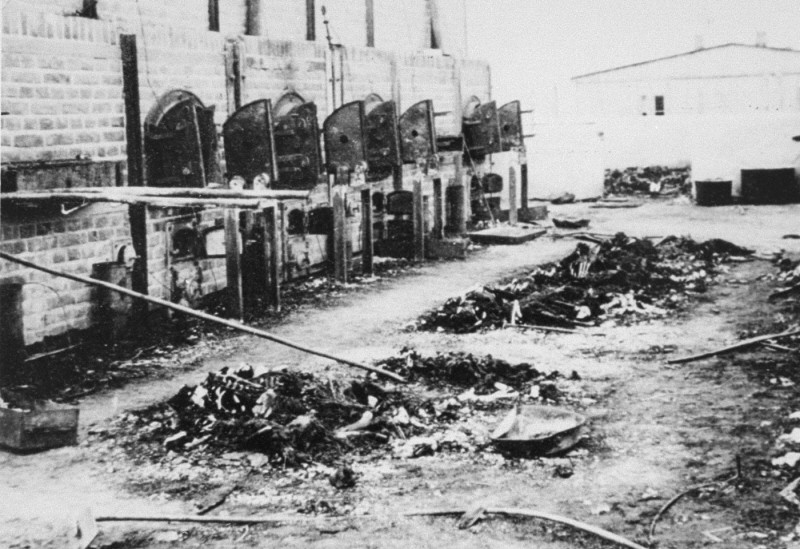
Lublin/Majdanek Concentration Camp: Conditions
Between 1933 and 1945, Nazi Germany and its allies established more than 44,000 camps and other incarceration sites (including ghettos). The perpetrators used these locations for a range of purposes, including forced labor, detention of people deemed to be "enemies of the state," and mass murder. Millions of people suffered and died or were killed. Among these sites was Majdanek, which had multiple purposes.
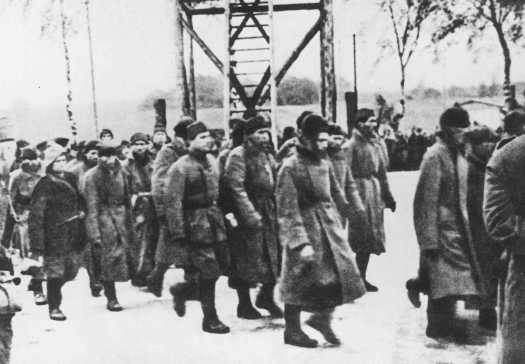
During the entire period of its existence, the Majdanek camp was under construction. Construction on the camp began in October 1941 with the arrival of about 2,000 Soviet prisoners of war. Most of the Soviet prisoners of war at Majdanek were too weak to work; virtually all were dead by February 1942. The SS also detailed Jewish forced laborers from the Lipowa Street camp, located in the center of Lublin, to help construct Majdanek. On December 11-12, 1941, the SS rounded up more than 300 Jews in the streets of Lublin and selected 150 of them as the first Jewish prisoners to be incarcerated in Majdanek. During January and February 1942, the SS and police selected Polish Jews from the Lublin ghetto and brought them to Majdanek for forced labor. In January and February 1942, the first non-Jewish Polish prisoners also arrived in Majdanek.
Conditions in the camp during the bitterly cold winter of 1941-1942 were lethal. The SS routinely shot prisoners too weak to work either on the edge of the camp grounds or in the Krepiecki Forest north of Lublin.
In spring 1942, the Germans began to implement the "Final Solution" in the Generalgouvernement within the framework of Operation Reinhard. From transports headed for the killing centers the SS diverted to Majdanek prisoners capable of work that they had selected, often while the train stood at the Lublin central train station. Between March 29 and mid-June 1942, some 7,000 Slovak Jews were diverted from Auschwitz and Belzec to Majdanek. The SS also selected Jews for labor from transports of German, Austrian, and Czech Jews destined for the camp ghettos in Izbica and Piaski and the Sobibor killing center.
By the summer of 1942, the SS and police had taken two thousand Czech Jews off trains transporting them from Theresienstadt to the Lublin District, and sent them to Majdanek as forced laborers. During the summer of 1942 deportations from the Warsaw ghetto to the Treblinka killing center, approximately 10,000 Jews, most of them in their twenties and thirties, were also diverted to Lublin as forced laborers; the SS sent an undetermined number of them to Majdanek.
As the Belzec killing center was closing down in autumn 1942, around 25,000 Jews who might have been destined for that killing center were sent to Majdanek. It is not clear whether the Germans killed these Jews immediately at Majdanek or whether they registered them as prisoners. If not killed upon arrival, virtually all of these Jews died or were killed over the next six months.
After the Germans destroyed the Warsaw ghetto in spring 1943, SS and police officials deported between 18,000 and 22,000 survivors of the uprising, including women and children, to Majdanek as forced laborers, along with the equipment of some of the Warsaw ghetto workshops. The SS intended that these prisoners would work for the benefit of a new SS-owned labor deployment concern, East Industries, Inc. (Ostindustrie, GmbH). The surviving documentation is insufficient to determine whether and how many of the Jewish survivors of the Warsaw ghetto were killed upon arrival at Majdanek. As many as 3,000 may eventually have been transferred to the Budzyn forced labor camp.
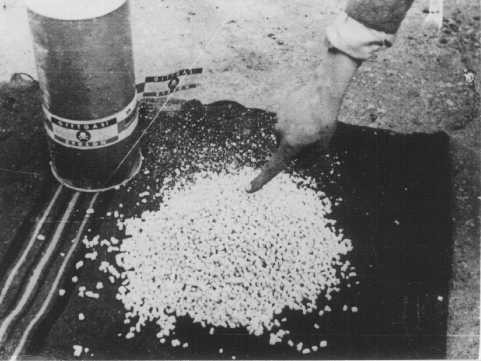
In the winter of 1941-1942, camp authorities began to use Zyklon B gas to murder prisoners too weak to work in a makeshift gas chamber. Mass murder operations using poison gas began at Majdanek in October 1942 and continued until the end of 1943. There appear to have been three gas chambers at Majdanek; at least two were shower rooms reconfigured for use of Zyklon B gas. At least one of these two was used to kill human beings. Some sources refer to a third gas chamber, which reportedly used carbon monoxide gas as a means of murder.
Majdanek also served another key Operation Reinhard function; it contained storage facilities for clothing and personal items stolen from the Jews before their deaths in the Belzec, Sobibor, and Treblinka II killing centers. Prisoners from Majdanek were also deployed at the large “Clothing Depot” (Bekleidungslager) located in Lublin city.
“Harvest Festival”
Made nervous by armed Jewish resistance during the Bialystok and Vilna ghetto deportations, respectively in August and September 1943, and by the uprisings in the Treblinka and Sobibor killing centers, respectively in August and October 1943, the SS leadership in Berlin decided to kill the remaining Jews in District Lublin, including those incarcerated at Majdanek.
On November 3, 1943, in Operation "Erntefest" (Harvest Festival), special SS and police units dispatched to Lublin specifically for that purpose shot 18,000 Jews just outside the camp. At least 8,000 of the victims were Majdanek prisoners; the remaining 11,000 were forced laborers from other camps or prisons in Lublin city. During the operation, music was played throughout the camp over loudspeakers to drown out the sounds of mass murder. As part of Operation "Erntefest," the November 3, 1943, massacre at Majdanek was part of the largest German-perpetrated massacre of the Holocaust.
Prisoners
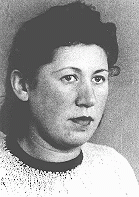
Between April 29, 1942, and November 3, 1943, Jewish prisoners were the overwhelming majority of prisoners registered at Majdanek. Recent research indicates that the SS deported between 74,000 and 90,000 Jews to the Majdanek main camp (excluding subcamps). At least 56,500 were Polish Jews: 26,000 from Lublin District; 20,000 from the Warsaw ghetto, 6,500 from the Bialystok ghetto, and roughly 4,000 deported between November 1943 and May 1944 from other labor camps.
At least 17,500 came from other European countries: 8,500 from Slovakia; 3,000 from Bohemia and Moravia; 3,000 from Germany and Austria; 2,000 from France, Holland and Greece; and 1,000 Jews from countries other than Poland transferred to Majdanek after November 3, 1943.
The SS killed tens of thousands of Jews at Majdanek. The majority of them arrived in Majdanek as forced laborers and either died as a result of the brutally inhumane living conditions or were killed in the gas chambers after the Germans determined that they could no longer work. Majdanek’s gas chambers were also used to kill prisoners from other camps in Lublin, such as the Lipowa Street camp in Lublin, who were no longer able to work. Some Jewish victims were killed in the gas chambers upon arrival, though presently available documentation does not permit estimates. Many, however, were killed in shooting operations. Many others died of disease, starvation, exposure and overwork.
Though it served primarily as a vast forced-labor camp for Polish Jews, Majdanek also served as a detention center for real and suspected members of the Polish underground resistance in the Generalgouvernement and for Poles suspected of violating the harsh provisions issued by the German occupation authorities that governed labor discipline. Next to Jews, Poles represented the largest minority in the camp. In mid-October 1942, out of a total of 9,519 registered prisoners in the camp, 7,468 were Jews (78.45%) and 1,884 were non-Jewish Poles (19.79%). In August 1943, there were 16,206 prisoners in the main camp: 9,105 were Jews (56.18%); and 3,893 (24.02%) were Poles. Other prisoners at Majdanek included Germans, Austrians, Czechs, Ukrainians, Soviet prisoners of war and Soviet civilians, and a handful of others.
Majdanek also frequently served as a transit camp or a temporary stop for Polish and Soviet civilians being deported to the Reich for forced labor or being held temporarily after the Germans removed them as undesirables in a resettlement project. For example, in 1943, German SS and police units removed about 16,000 Poles from Zamosc county, southeast of Lublin, and held them temporarily in Majdanek. Himmler had ordered the "cleansing" of Polish villages from Zamosc county as the first step in the so-called Germanization of Poland. The Germans expelled about 110,000 Poles from the region. Thousands were deported to Auschwitz and Majdanek and thousands of others to forced labor in Germany.
After the “Harvest Festival” killings, Lublin/Majdanek no longer had a majority of Jews among its prisoners. At the end of 1943, of 6,562 prisoners registered at Majdanek, approximately 71 were Jews. In mid-March 1944, as surviving Jews from various subcamps of Majdanek were brought to the main camp for eventual evacuation west to Auschwitz and other concentration camps in the Reich, 834 Jews were imprisoned in Majdanek. Some were killed in the gas chambers between March and July 1944; the SS transferred the rest to Auschwitz and Plaszow.
Subcamps
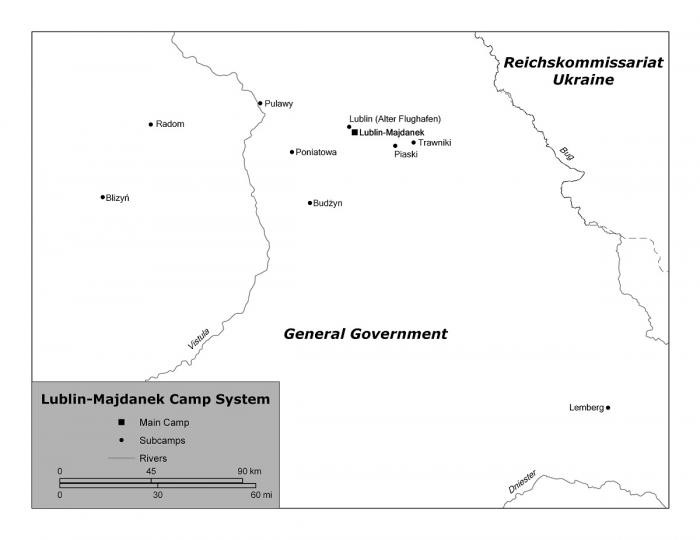
Prior to its formal conversion to a concentration camp, Majdanek did not have formal subcamps. In the early autumn of 1943, the surviving forced labor-camps in District Lublin—Budzyn, Trawniki, Poniatowa, Krasnik, Pulawy, and the Airstrip and Lipowa camps in Lublin—became subcamps of Majdanek. Six weeks later, Poniatowa and the two Lublin camps were dissolved after their Jewish prisoners were murdered during “Harvest Festival.” A small Jewish labor detachment remained at Trawniki until the transfer of its approximately 50 prisoners to Majdanek in May 1944. Budzyn, due to its connection to a Heinkel aircraft parts factory, survived until the transfer of the last 1,000 prisoners to Majdanek in May 1944.
Krasnik was dissolved in March 1944; its prisoners were transferred to Majdanek. Pulawy was evacuated in July 1944; the fate of its small Jewish labor detachment is unknown.
In the first months of 1944, Majdanek took over as new subcamps other forced-labor camps for Jews outside District Lublin, including Blizyn in District Radom; Radom city; and the Warsaw subcamp, located on the ruins of the Warsaw ghetto.
Liberation
The SS evacuated most of the prisoners to concentration camps further west during the spring of 1944. In late July 1944, as Soviet forces approached Lublin, the remaining camp staff hastily abandoned Majdanek, without fully dismantling the camp. Soviet troops first arrived at Majdanek during the night of July 22–23 and captured Lublin on July 24. Captured virtually intact, Majdanek was the first major concentration camp to be liberated. Soviet officials invited journalists to inspect the camp and evidence of the horrors that had occurred there.
Critical Thinking Questions
- How do the multiple functions of this camp illustrate the systematic nature of the “Final Solution?”
- Was the local population aware of the functions of the camp?
- Majdanek was the first major Nazi campt to be overrun by Allied troops. How did information about this camp reach the outside world? What did the public in your country know about the mass killing process at this time?

